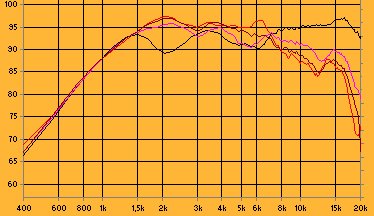[Products]
[Press + Media]
[Basics]
[Technology]
[Application]
[Shop]
[FAQ]
[Contact]
[Links]
[Site Notice]
What´s the job of a loudspeaker speaker?
ISomewhere in the net we found the following, which we think it a very good description of the job of the “driver and speaker construction (design?)” " Music is art, sound is engeneering"
You could describe the basic from audio consequence heretical also with „ No voodoo, just physics“
A speaker is no music instrument and it must not be. It has to reproduce possibly uninfluenced what the musician or recording engineer want us to hear. It shouldn´t make his own sound, but reproduce those which was created by the artist.
But if a speaker or another part of the reproduction chain makes his own sound, it can be felt comfortable – depending on the listening taste or music style. How can that be?
The simple explanation is, that the suitability for a special music style in our view doesn´t mean a strength, but a weakness. The weakness that certain criterias – which were needed for other music styles or recording philosophies- aren´t there . In some recordings, these criterias are not needed, but in others.
The aim is the original, but what is this original?
If a violine or some drums doesn´t sound with our speakers like we know them from live performances, there can be some different reasons:
Maybe it is another violine. Or just older strings. Also possible that the recording room was damped better than ours. Maybe they took another microphone in another angle or another distance to the instrument etc. If now a speaker would tries to neutralize all these influences and to get reborn the same violine we listened live the evening before, it could succeed. But we would have to pay the price, that all other instruments and recordings were skewed for exactly this correction. This can happen, but it must not happen.
For this reason we wanted to create speakers, which reproduce exactly what is included on the LP,CD or any other source. It is the decision of the artist and the engineers if we`ll like this sound – but never a decision of the speakers.
Therefore the aim of a universal speaker, that fits for all styles - like classical music, unplugged or heavy metal- is to give us the entire frequency spectrum, without intonation or keeping off anything. Everything else is taken over by the artists.
Unfortunately, it is not so simple and often our idea of the ideals is influenced by that, what we have learned to be true. Today a exactly horizontal line as frequency response is considered the ideal. Is it really? How this line was created?
The supposed most important measurement of a speaker is the frequency response on axis, that means, the microphone is exactly on an angle of 0 ° in front of the speaker. As described in “Why coaxial” this is not so easy. In a conventional multi-way speaker, the horizontal position 0 ° is defined exactly, but what happens in the vertical? If the microphone is placed at the height of the tweeter or the woofer or between makes a huge difference. Wich position ist correct?
Fortunately we doesn´t have this problem with coaxial speakers and we can dedicate ourselves to another question:
|
Does " linear on axis" means also „linear at the ear”? Linear on axis means that a linear frequency response (without considering the listening room) is projected only exactly in one vector from the speaker. Due to physical causes, high frequencies decrease with increasing listening angle, so the highs are already less reproduced when we move away just a little bit of this one vector. It could help to sit always in the same position and to set the tweeter always to this point. The neighbour is unlucky. So if you prefer this solution, take a good headphone. |
Ttypical frquency response of a tweeter under different angles |
It seems much more better to take care that the whole energy dissipation of a speaker is constantly all over the frequency. Because high notes are bundled increasingly, it seems to make the 0 ° frequency response so that a course is slightly increasing. That means the average of the trace in different angles should be the ideal of a horizontally line and not the maximum, which we have normally at an angle of 0°.
Copyright(c) 2018 Audio Consequence. Alle Rechte vorbehalten.
